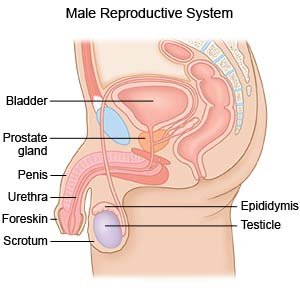Laser Prostatectomy
Medically reviewed by Drugs.com. Last updated on Sep 23, 2025.
Laser prostatectomy is surgery that uses a laser light beam to destroy part of the prostate gland. This can help reduce urinary problems caused by an enlarged prostate.
 |
DISCHARGE INSTRUCTIONS:
Call your doctor or surgeon if:
- You cannot urinate, or if you have a catheter, no urine is filling the bag.
- Your catheter comes out of your urethra.
- You have lower abdomen or back pain that does not go away with medicine.
- You have redness, pain, blood, or drainage where the catheter enters your penis.
- Your urine is red, cloudy, and foul smelling.
- You have a fever.
- Your symptoms get worse.
- You have blood in your urine.
- You have chills, a cough, or feel weak and achy.
- You are dizzy, have nausea, or are vomiting.
- You have questions or concerns about your condition or care.
Medicines:
You may need any of the following:
- Prescription pain medicine may be given. Ask your healthcare provider how to take this medicine safely. Some prescription pain medicines contain acetaminophen. Do not take other medicines that contain acetaminophen without talking to your healthcare provider. Too much acetaminophen may cause liver damage. Prescription pain medicine may cause constipation. Ask your healthcare provider how to prevent or treat constipation.
- Steroids may be given to reduce swelling.
- Antibiotics help prevent or fight an infection caused by bacteria.
- Take your medicine as directed. Contact your healthcare provider if you think your medicine is not helping or if you have side effects. Tell your provider if you are allergic to any medicine. Keep a list of the medicines, vitamins, and herbs you take. Include the amounts, and when and why you take them. Bring the list or the pill bottles to follow-up visits. Carry your medicine list with you in case of an emergency.
Related medications
Foley catheter care:
A Foley catheter is a tube put into your bladder to drain your urine into a bag. Keep the bag below your waist. If the bag is too high, urine will flow back into your bladder. This can cause an infection. Do not pull on the catheter. This may cause pain and bleeding, and the catheter may come out. Do not let the catheter tubing kink or twist. A kink or twist will block the flow of urine.
Bladder care:
- Empty your bladder regularly. Try to urinate every 3 hours while you are awake. Do not let your bladder become too full. Urinate as soon as you feel the need. Do not drink liquids before you go to bed. Urinate right before you go to bed.
- Follow instructions for catheterization. You may need to catheterize yourself if you cannot urinate on your own. Ask for more information on self-catheterization.
Self-care:
- Rest as needed. Slowly begin doing more each day. Return to your daily activities as directed.
- Prevent constipation. Eat foods that are high in fiber, and drink more liquids. High-fiber foods, such as fruits, vegetables, and whole grains, will help soften your bowel movements. Regular exercise and extra liquids also help prevent constipation.
- Ask your healthcare provider when it is safe to have sex. Do not get sexually aroused without ejaculating. Your urethra may get blocked.
- Do not smoke. Smoking increases the time it takes to heal. Ask your healthcare provider for information about how to stop smoking if you need help.
Follow up with your doctor or surgeon as directed:
Write down your questions so you remember to ask them during your visits.
© Copyright Merative 2025 Information is for End User's use only and may not be sold, redistributed or otherwise used for commercial purposes.
The above information is an educational aid only. It is not intended as medical advice for individual conditions or treatments. Talk to your doctor, nurse or pharmacist before following any medical regimen to see if it is safe and effective for you.
Further information
Always consult your healthcare provider to ensure the information displayed on this page applies to your personal circumstances.
